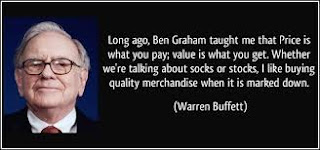The price-to-earnings
ratio (P/E) is an investment metric commonly used by investors to
help determine whether or not the price they’re paying for a company represents
a good value. As Warren Buffett is oft
quoted, “Price is what you pay. Value is
what you get.”
 |
| Know the difference between price and value. |
Price-to-earnings can signal many things. For instance, if the price per share is 40 or
50 times the current earnings per share of a firm, investors may take that
information to mean the company is expected to grow its revenues quickly. In other words, investors are paying for
“promise”.
Conversely, a firm with a share price only 7 or 8 times
current earnings per share can be viewed negatively. Investors may presume the firm’s growth
prospects to be negligible since the market isn’t willing to pay a far larger
multiple for the promise of increasing future earnings.
Since signs of growth get media attention and lots of
“votes” in the market, investors often gravitate to stocks with high
price-to-earnings multiples, increasing the demand, driving up the price, and
widening the P/E ratio even further.
Stocks found in a cycle in which excess demand is driven by perception
may be referred to as “over bought”.
To avoid paying too much for over bought shares, I prefer
Dividend Champions. In Dividend Farming
the objective is to maximize the return while minimizing the risk; the risk of
paying too much for an investment.
Stocks with solid records of dividend growth aren’t usually
equated with high growth companies in the context of stock valuation. As a result, they’re not inclined to be over
bought by institutions, momentum investors, day traders, and the like.
Below are the 10 Dividend Champions with the lowest, generally best,
P/E as of 1/31/19.
Company
|
P/E
|
Consolidated Edison
|
3.53
|
Black Hills Corp.
|
6.76
|
Old Republic International
|
7.22
|
NACCO Industries
|
7.80
|
Artesian Resources
|
8.49
|
Franklin Resources
|
9.20
|
Nucor Corp.
|
10.16
|
First Financial Corp.
|
11.42
|
Eaton Vance Corp.
|
11.64
|
Community Trust Banc.
|
12.12
|
Knowing Dividend Champions are less susceptible to trend
induced price inflation than alternatives isn’t a cure-all by itself. The P/E ratio is still one of several
indicators of a company’s ability to be profitable in general.
Because price-to-earnings is a ratio it’s possible to have
the ratio widen not because the stock is over-bought, but because the firm is
struggling to generate earnings.
Mathematically you can increase the ratio by increasing the numerator (over-priced)
while holding the denominator steady, or decreasing the denominator (poor
earnings) while holding the numerator steady, or some combination of the two.
Looking for firms with low P/E and other solid metrics, like
length of dividend payments, debt-to-equity, and Price-to-Book, discussed in a
future post, helps determine whether the price being asked for a particular
issue represents a good value.
In the case of the 10 Dividend Champions with the best P/E
ratio a true value investor will look beyond that metric alone before adding to
his or her dividend farm. However,
filtering by Dividend Champion and rock solid P/E ratios is not a bad way to
begin the selection process.
With that said, be careful when looking at P/E. Using the P/E based on the trailing
twelve-month (TTM) earnings means the ratio is based on something akin to fact. Alternatively, some investors are interested
in the P/E incorporating earnings projections for the coming year.
In my view using the forecast means my P/E decision criteria
becomes one of shear speculation. In the
aviation industry it’s said good information leads to good decisions. Speculation should not be mistaken for good
information whether you’re flying airplanes or farming dividends. Best practice suggests sticking with the TTM
in the price-to-earnings calculation to help generate the margin of safety in
your investment and keeping your Dividend Farm
healthy and growing properly.
The
thoughts and opinions expressed here are those of the author, who is not a
financial professional. Perspectives offered should not be considered
investment advice. They are presented for discussion and entertainment
purposes only. For specific investment advice or assistance, please
contact a registered investment advisor, licensed broker, or other financial professional.



